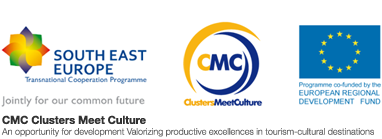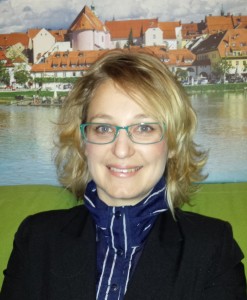Stakeholder’s point of view: interview with Janja Viher (Manager Maribor – Pohorje Tourist Board, Public Institution)
Are there any integrations (clusterings) visible in the area of culture and tourism in Slovenia?
An example of clustering could be seen within the ECC (European Capital of Culture) project, but it should be upgraded with appropriate contents in the future. The Maribor – Pohorje Tourist Board is the trademark holder; however, cultural institutions, independent cultural workers and others must be our key partners in the implementation of programmes and in the promotion of cultural tourism in Maribor, in the area of the tourist destination, and in partner cooperation with other cities included in the ECC project and with other interested parties. Of course, the key issue is the marketing of cultural tourism, which must be interesting to agencies and other partners, who have a decisive role in marketing.
Is the local mentality inclined to such and similar integrations, which might contribute to a greater recognisability and effects in the area of tourism?
From a local point of view integration and cooperation in the area of tourism is still in early stages, because participants have not yet adopted the concept of effective integration of ideas, strengths and finances, which might bring positive results.
During the last year the Maribor – Pohorje Tourist Board has placed a lot of emphasis on the integration of various tourist entities (such as, in organizing events, publication of promotion materials, etc.), however, it is clear that much more effort has to be invested in this area.
Events, such as the Old Vine Festival, St. Martin’s Day celebration in Maribor and Magical December, are also a good example of cooperation.
As regards the latter I can confirm with certainty that such a positive experience gives a clear vision for the future, so that next year we will start the programme early enough to be able to support it in terms of promotion, and offer it to agencies and other participants.
Are there any local entities visible in the area of creative industries (such as, DUO, Soven, etc.)?
Creative industry is the future of cultural tourism; the term “industry” might be somewhat inappropriate, because in tourism we don’t want any emphases on industry; “industry” in our heads still calls for unwanted associations and leads to beliefs that tourism is also industrial, which extinguishes the flame of innovativeness before it’s actually been kindled. If we want to be creative, innovative, different from competitive destinations, this should be a creative destination, a creative place. Potential players of clustering in the area of Maribor tourism are: artists and craftsmen, food growers, organizers of eating habits, fashion designers in relation to the school of textiles and design, schools for tourism and catering, and other tourist institutions and companies. We already have excellent potentials and providers, both institutions and consortiums as well as private undertakings (ArtMar, Akademija samooskrbe kmetij (Academy for Self-sufficiency of Farms), Višja šola za gostinstvo in turizem Maribor (Vocational College for Catering and Tourism Maribor), Srednja šola za gostinstvo in turizem Maribor (Secondary School for Catering and Tourism Maribor, etc.).
Do you think there are any solid links between the production sector and culture in your region?
If we refer to the creation of the brand of the Old Vine and the contents we perform in the Old Vine House I believe that in this specific example we managed to achieve superb integration of winegrowers, caterers, cultural workers, gourmet enthusiasts, and institutions of various segments, and to support the production sector and culture through the contents we perform. However, there are plenty more challenges and possibilities. In this segment we want to give a greater emphasis to the wine culture as a part of the culture of our destination.
The other bright example is theme tours in the area of culture – independent and/or in cooperation with cultural institutions. The project MIKROTUR that has been implemented within the TOTI LAS project (by MRA p.o.) also brings results that are appropriate integral tourist packages, which integrate the ethnological treasure trove of countryside into an effective and interpretatively interesting offer of the countryside. Another key factor here is the solid cooperation with the Municipal Tourist Association and the Štajerska Tourist Association, which are key partners in the formation of creative, ethnologically and culturally diverse contents of numerous individuals and associations from the city and villages of a wider area, which greatly contribute to the revival and preservation of culture.
Would a public private partnership represent an appropriate model for a bigger tourist promotion?
Public private partnership can certainly be an effective model, because we all strive towards higher market shares. As can be seen through the intentions of the integration with cultural institutions, the interest of the latter is only the implementation of the programme, which is payable from cultural contents for public needs, while any clear interest for marketing activity is not expressed. In accordance with the Development strategy of the Maribor – Pohorje tourist destination for 2010-2020, the model of public private partnerships is appropriate particularly for investments, such as, the renovation and revival of parts or individual bigger buildings of the old town centre with tourist services, the renovation and revival of castles and mansions and their surroundings with a tourist valuation throughout the area of the destination, the construction or renovation of sports and recreational programmes and facilities, the construction or renovation and extension of buildings intended for cultural activities, the development and construction of bigger, so-called “greenfield” investment projects in the area of tourism connected to required bigger surfaces of lands and infrastructure (which is in fact publicly-owned), and the development and partnership in projects for the development of water surfaces. But, in order to facilitate the development of tourism through public private partnerships, in the first place public sectors (cities, municipalities) must clearly identify potential assets, locations, projects and conditions for their placement in a public private partnership and design initial programmes and cost estimates for private investors in domestic and international capital markets.
What do you expect from the CMC project?
We believe that the Maribor – Pohorje Tourist Board will also be included in the CMC project with its ideas, knowledge and experience, because only networking brings effective results, which might also serve as the basis for the stories of success.
As I gaze out to the future I would like to mention the possibilities provided by the next financial perspective, which will enable such projects and contents, and we believe that with effective partnerships we will be able to make a step forward in this area and a breakthrough of culture in relation to tourism.

